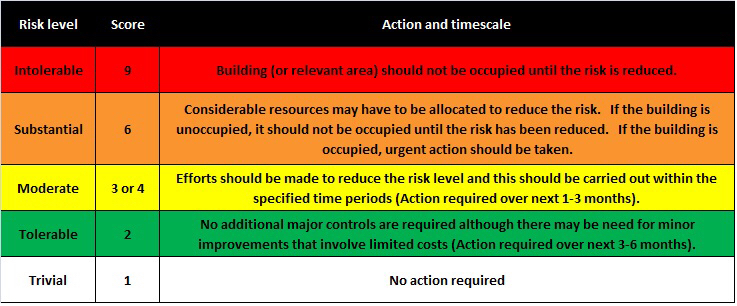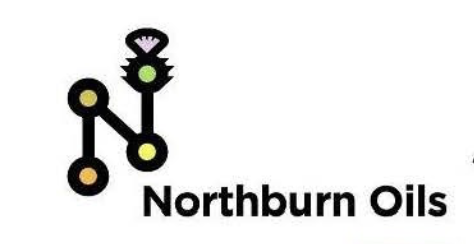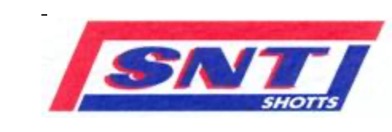Information
-
Address of Premises
-
Date of fire risk assessment review
-
Assessor
COVER SHEET
-
Employer or person having control of the premises:
-
Person(s) consulted:
-
Date of previous fire risk assessment / review:
-
Have all actions from previous FRA / review been completed? <br>(Outstanding actions will be carried over to new Fire Risk Assessment Action Plan)
-
Suggested date for review of fire risk assessment 1):
-
Refer to the original fire risk assessment for full details about the premises, room sizes, occupancy capacities, floor plans etc.
-
The purpose of this report is to provide an assessment of the risk to life from fire in these premises, and, where appropriate, to make recommendations to ensure compliance with fire safety legislation.
The report does not address the risk to property or business continuity from fire.
I certify that to the best of my knowledge, the information contained in this fire risk assessment is correct, based on information provided at the time the assessment was undertaken. -
1) The original fire risk assessment should be reviewed again by a competent person by the date indicated above or at such earlier time as there is reason to suspect that it is no longer valid, or there has been significant change in the matters to which it relates, or if a fire occurs.
GENERAL INFORMATION
Significant changes identified since the time of the previous fire risk assessment (FRA) in respect of:
SECTION 1 - THE PREMISES
-
1.1 - The premises:
SECTION 2 - THE OCCUPANTS
-
2.1 - Approximate maximum number of persons*:
-
*Total maximum escape capacity for the premises, including employees, not to exceed the figure above due to the available escape width.
-
2.2 - Approximate maximum number of employees at any one time:
-
2.3 - Approximate maximum number of other employees / contractors / lease holders at any one time:
-
It should be noted that not all persons in 2.3 above are located on the premises at all times.
-
2.4 - Associated times/hours of occupation:
SECTION 3 - OCCUPANTS AT SPECIAL RISK FROM FIRE
-
3.1 - Sleeping occupants?
-
3.2 - Disabled occupants?**
-
3.3 - Occupants in remote areas and Lone Workers?
-
3.4 - Young Persons?**
-
3.5 - Others?
-
** It should be noted that whilst there are no persons permanently located; contractors, visitors and specific groups and / or individuals could give rise to this figure at any given time.
SECTION 4 - FIRE LOSS EXPERIENCE
-
4.1 - Has there been any fire loss reported since the previous fire risk assessment?
SECTION 5 - OTHER RELEVANT INFORMATION
-
undefined
SECTION 6 - RELEVANT FIRE SAFETY LEGISLATION
-
6.1 - The following fire safety legislation applies to these premises:
Fire (Scotland) Act 2005
Fire Safety (Scotland) Regulations 2006
Fire Safety (Scotland) Amendment Regulations 2010 -
6.2 - The above legislation is enforced by: Scottish Fire & Rescue Service
-
6.3 - Other legislation that makes significant requirements for fire precautions in these premises (other than the Building (Scotland) Regulations 2004):
-
6.3.1 - Enter details if applicable
-
6.4 - The FRA review also takes account of the Scottish Government Practical Fire Safety Guidelines for Places of Entertainment and Assembly.
FIRE HAZARDS AND THEIR ELIMINATION OR CONTROL
Significant changes in measures to prevent fire since the time of the previous fire risk assessment:
-
undefined
SECTION 7 - ELECTRICAL SOURCES OF IGNITION
-
7.1 - Reasonable measures taken to prevent fires of electrical origin?
-
7.2 - Fixed wiring installation periodically inspected and tested?
-
7.3 - Portable appliance testing (where appropriate) carried out?
-
7.4 - Suitable policy regarding the use of personal electrical appliances?
-
7.5 - Suitable limitation of trailing leads and adapters?
SECTION 8 - SMOKING
-
8.1 - Reasonable measures taken to prevent fires as a result of smoking?
-
8.2 - Smoking prohibited on the premises?
-
8.3 - Does the no smoking policy appear to be observed at time of inspection?
SECTION 9 - WILFUL FIRE RAISING
-
9.1 - Does basic security against wilful fire raising by outsiders appear reasonable?
-
9.2 - Is there an absence of unnecessary fire load in close proximity to the premises or available for ignition by outsiders?
SECTION 10 - PORTABLE HEATERS AND HEATING INSTALLATIONS
-
10.1 - Is the use of portable heaters avoided as far as practicable?
-
10.2 - If portable heaters are used, is the use of the more hazardous type (e.g. radiant bar fires or lpg appliances) avoided?
-
10.3 - If portable heaters are used are suitable measures taken to minimise the hazard of ignition of combustible materials?
-
10.4 - Are fixed heating installations subject to regular maintenance?
SECTION 11 - COOKING
-
11.1 - Are reasonable measures taken to prevent fires as a result of cooking?
-
11.2 - Are filters changed and ductwork cleaned regularly?
-
11.3 - Are suitable extinguishing appliances available?
SECTION 12 - LIGHTNING PROTECTION
-
12.1 - Do the premises have a lightning protection system?
-
12.2 - Has the Lightning protection system been maintained and inspected at a minimum of 12 monthly intervals?
SECTION 13 - HOUSEKEEPING
-
13.1 - Is the standard of housekeeping adequate?
-
13.2 - Are combustible materials separated from ignition sources?
-
13.3 - Is there an avoidance of unnecessary accumulation of combustible materials or waste?
-
13.4 - Is there appropriate storage of hazardous materials?
-
13.5 - Is there avoidance of inappropriate storage of combustible materials?
SECTION 14 - OUTSIDE CONTRACTORS AND BUILDING WORKS HAZARDS
-
14.1 - Are fire safety conditions imposed on outside contractors?
-
14.2 - Is there satisfactory control over works carried out on the premises by outside contractors (including "hot work" permits)?
-
14.3 - If there are in-house maintenance personnel, are suitable precautions taken during "hot work", including use of "hot work" permits
SECTION 15 - DANGEROUS SUBSTANCES
-
15.1 - Have the hazardous properties of dangerous substances been considered?
-
15.2 - If 16.1 applies, has a specific risk assessment been carried out, as required by the Dangerous Substances and Explosive Atmospheres Regulations 2002?
SECTION 16 - OTHER SIGNIFICANT IGNITION SOURCES THAT WARRANT CONSIDERATION INCLUDING PROCESS HAZARDS THAT IMPACTS ON GENERAL FIRE PRECAUTIONS?
-
16.1 - Are all plant areas, boiler houses, electrical switch rooms, or any other room or space containing a fixed source of ignition, clear of storage of combustible materials?
-
16.2 - Is all upholstered furniture free of damage to the coverings and do they meet the standards in the Furniture and Furnishings (Fire) (Safety) Regulations?
-
16.3 - Is there suitable separation between light bulbs / heating appliances and flammable/combustible materials?
-
16.4 - Are there other significant ignition sources present?
FIRE PROTECTION MEASURES
SIGNIFICANT CHANGES IN FIRE PROTECTION MEASURES SINCE THE TIME OF THE PREVIOUS FRA:
-
undefined
SECTION 17 - MEANS OF ESCAPE
-
17.1 - It is considered that the premises are provided with reasonable means of escape in case of fire?
-
17.2 - Is there adequate design of escape routes?
-
17.3 - Is there adequate provision of escape exits?
-
17.4 - Are exits easily and immediately openable where necessary?
-
17.5 - Do fire exits open in direction of escape where necessary?
-
17.6 - Are sliding or revolving doors avoided as fire exits where necessary?
-
17.7 - Are there satisfactory means for securing exits?
-
17.8 - Are travel distances reasonable where there is a single direction of travel?
-
17.9 - Are alternative means of escape travel distances reasonable?
-
17.10 - Is there suitable protection of escape routes?
-
17.11 - Are suitable fire precautions provided for all inner rooms and inner inner rooms?
-
17.12 - Are all escape routes unobstructed?
-
17.13 - Are all external escape routes unobstructed and providing a clear route to the fire assembly points?
-
17.14 - Is the premises provided with reasonable arrangements for means of escape for disabled people?
SECTION 18 - MEASURES TO LIMIT FIRE SPREAD AND DEVELOPMENT
-
18.1 - It is considered that there is compartmentation of a reasonable standard?
-
18.2 - Are fire doors being wedged open or held open?
-
18.3 - Are fire doors holed or damaged?
-
18.4 - Is fire door integrity/strips/seals and all door furniture adequately maintained?
-
18.5 - It is considered that there is reasonable limitation of linings that might promote fire spread
-
18.6 - As far as can reasonably be ascertained, fire/smoke dampers are provided as necessary to protect critical means of escape against passage of fire, smoke and combustion products in the early stages of a fire?
SECTION 19 - EMERGENCY ESCAPE LIGHTING
-
19.1 - Reasonable standard of emergency escape lighting provided, based on visual inspection?
SECTION 20 - FIRE SAFETY SIGNS AND NOTICES
-
20.1 - Reasonable standard of fire safety signs and notices?
-
20.2 - All fire exit routes, final exits clearly identified by appropriate signage?
-
20.3 - Fire action notices displayed next to all fire alarm call points, fire extinguisher locations and final exits?
SECTION 21 - MEANS OF GIVING WARNING IN CASE OF FIRE
-
21.1 - Is a reasonable manually operated electrical fire alarm system provided?
-
21.2 - Automatic fire detection provided?
- YES, throughout premises
- YES, part of premises only
- NO
-
21.3 - Where there is no manually operated fire alarm system provided are there suitable arrangements in place to alert building users?
-
21.4 - Can the means of warning be clearly heard or be perceptible and understood by everyone throughout the whole building when initiated from a single point?
-
21.5 - Extent of automatic fire detection generally appropriate for the occupancy and fire risk?
-
21.6 - Is there a remote transmission of alarm signal?
-
21.7 - Is the fire panel located at an exit and readily accessible to the emergency services ?
-
21.8 - Is a schematic zone plan of the fire alarm system provided adjacent to the main control panel?
SECTION 22 - PORTABLE FIRE EXTINGUISHING APPLIANCES
-
22.1 - Reasonable provision of portable fire equipment?
-
22.2 - Are all portable fire fighting equipment readily accessible and highlighted by signage?
-
22.3 - Are all portable fire fighting appliances inspected annually by Contractor?
-
Date of latest service / inspection by Contractor.
SECTION 23 - AUTOMATIC FIRE EXTINGUISHING SYSTEMS
-
23.1 - Type(s) of system:
SECTION 24 - OTHER RELEVANT FIXED SYSTEMS AND EQUIPMENT
-
24.1 - Type of fixed system:
MANAGEMENT OF FIRE SAFETY
Significant changes in management of fire safety since the time of the previous fire risk assessment.
-
undefined
SECTION 25 - PROCEDURES AND ARRANGEMENTS
-
25.1 - Are arrangements for management of fire safety adequate?
-
25.2 - Appropriate fire procedures in place and properly documented?
-
25.3 - Are there suitable arrangements for summoning the fire and rescue service?
-
25.4 - Are there suitable arrangements to meet the fire and rescue service on arrival and to provide them with relevant information?
-
25.5 - Are there suitable arrangements for ensuring that the premises have been evacuated?
-
25.6 - Is there a suitable fire assembly point(s)?
-
25.7- Are there adequate procedures for evacuation of any disabled people who are likely to be present?
-
25.8 - Have sufficient fire wardens been appointed to cover all shift patterns, periods of absence?
-
25.9 - Are persons nominated and trained to use fire extinguishing appliances?
-
25.10 - Are persons nominated and trained to assist with evacuation, including evacuation of disabled people?
SECTION 26 - TRAINING AND DRILLS
-
26.1 - Are the arrangements for staff training and fire drills adequate?
-
26.2 - Are all staff given adequate fire safety instruction and training on induction?
-
26.3 - Are all staff given ongoing fire safety training within the past 12 months?
-
26.5 - Are staff with special responsibilities e.g. fire wardens, evac-chair operators given additional training?
-
26.6 - Are regular planned fire drills carried out at appropriate intervals?
-
26.6.1 - Enter date of latest planned fire evacuation drill.
-
26.7 - Are there suitable arrangements for informing site based contractors, lease holders and staff providing temporary cover of the premises fire procedures?
-
26.8 - Are employees provided with adequate instruction and information regarding fire risks and general fire precautions for other organisations in the premises?
SECTION 27 - TESTING AND MAINTENANCE
-
27.1 - Are the arrangements for testing and maintenance of fire protection systems and equipment adequate?
-
27.2 - Weekly testing and periodic servicing of fire detection and alarm system?
-
27.3 - Monthly and annual testing routines for emergency escape lighting?
-
27.4 - Annual maintenance of fire extinguishing appliances?
-
27.5 - Weekly testing and periodic inspection of sprinkler installations?
-
27.6 - Six-monthly inspection and annual testing of rising mains and fire hydrants?
-
27.7 - Weekly and monthly testing, six-monthly inspection and annual testing of fire-fighting lifts?
-
27.8 - Periodic inspection of external escape staircase and gangways?
-
27.9 - Routine checks of final exit doors and/or security fastenings?
-
27.10 - Annual inspection and test of lightning protection system?
-
27.11 - Are suitable systems in place for reporting and subsequent restoration of safety measures that have fallen below standard?
-
27.12 - Other relevant inspections or tests carried out:
SECTION 28 - RECORDS
-
Are there appropriate records for the following:
-
28.1.1 - Fire evacuation drills?
-
28.1.2 - Fire safety training?
-
28.1.3 - Fire alarm tests?
-
28.1.4 - Emergency lighting tests?
-
28.1.5 - Maintenance and testing of other fire protection systems?
FIRE RISK ASSESSMENT
LIKELIHOOD
-
-
Taking into account the fire prevention measures observed at the time of this risk assessment, it is considered that the hazard from fire (probability/likelihood of ignition) at these premises is:
- LOW
- MEDIUM
- HIGH
SEVERITY
-
-
Taking into account the nature of the premises and the occupants, as well as the fire protection and procedural arrangements observed at the time of this fire risk assessment, it is considered that the Severity (consequences for life safety), in the event of fire would be:
- MINOR HARM
- MAJOR HARM
- CRITICAL HARM
RISK LEVEL
-
-
Accordingly, it is considered that the risk to life from fire at these premises is:
- TRIVIAL
- TOLERABLE
- MODERATE
- SUBSTANTIAL
- INTOLERABLE
ACTION & TIMESCALE
-
A suitable risk-based control plan should involve effort and urgency that is proportionate to risk.
The following risk-based plan is based on one advocated by PAS79, the industry recognised guidance for fire risk assessment. -
An update for the actions identified in this fire risk assessment is required to be submitted to GL Health and Safety no later that 8 weeks from receipt of the assessment.
In addition, the action plan will be reviewed by the Manager / Supervisor and forwarded to GL Health and Safety twice yearly every January and July.
SIGNATURE
-
Assessors Signature



















